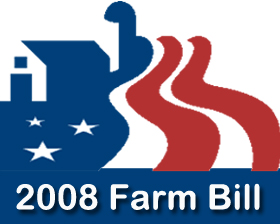
Insurance is a means of protection from financial loss in which, in exchange for a fee, a party agrees to compensate another party in the event of a certain loss, damage, or injury. It is a form of risk management, primarily used to protect against the risk of a contingent or uncertain loss.

The Agricultural Adjustment Act (AAA) was a United States federal law of the New Deal era designed to boost agricultural prices by reducing surpluses. The government bought livestock for slaughter and paid farmers subsidies not to plant on part of their land. The money for these subsidies was generated through an exclusive tax on companies that processed farm products. The Act created a new agency, the Agricultural Adjustment Administration, also called "AAA" (1933–1942), an agency of the U.S. Department of Agriculture, to oversee the distribution of the subsidies. The Agriculture Marketing Act, which established the Federal Farm Board in 1929, was seen as an important precursor to this act. The AAA, along with other New Deal programs, represented the federal government's first substantial effort to address economic welfare in the United States.
The Monsanto Company was an American agrochemical and agricultural biotechnology corporation founded in 1901 and headquartered in Creve Coeur, Missouri. Monsanto's best-known product is Roundup, a glyphosate-based herbicide, developed in the 1970s. Later, the company became a major producer of genetically engineered crops. In 2018, the company ranked 199th on the Fortune 500 of the largest United States corporations by revenue.

Agriculture is a major industry in the United States, which is a net exporter of food. As of the 2017 census of agriculture, there were 2.04 million farms, covering an area of 900 million acres (1,400,000 sq mi), an average of 441 acres per farm.
Terrorism insurance is insurance purchased by property owners to cover their potential losses and liabilities that might occur due to terrorist activities.
Political risk insurance is a type of insurance that can be taken out by businesses, of any size, against political risk—the risk that revolution or other political conditions will result in a loss.
Crop insurance is insurance purchased by agricultural producers and subsidized by a country's government to protect against either the loss of their crops due to natural disasters, such as hail, drought, and floods ("crop-yield insurance", or the loss of revenue due to declines in the prices of agricultural commodities.

The Risk Management Agency (RMA) is an agency of the U.S. Department of Agriculture, which manages the Federal Crop Insurance Corporation (FCIC). The current Administrator is Marcia Bunger.

The Terrorism Risk Insurance Act (TRIA) is a United States federal law signed into law by President George W. Bush on November 26, 2002. The Act created a federal "backstop" for insurance claims related to acts of terrorism. The Act "provides for a transparent system of shared public and private compensation for insured losses resulting from acts of terrorism." The Act was originally set to expire December 31, 2005, was extended for two years in December 2005, and was extended again on December 26, 2007. The Terrorism Risk Insurance Program Reauthorization Act expired on December 31, 2014.

The Agricultural Adjustment Act of 1938 was legislation in the United States that was enacted as an alternative and replacement for the farm subsidy policies, in previous New Deal farm legislation, that had been found unconstitutional. The act revived the provisions in the previous Agriculture Adjustment Act, with the exception that the financing of the law's programs would be provided by the Federal Government and not a processor's tax, and was also enforced as a response to the success of the Soil Conservation and Domestic Allotment Act of 1936.

In the United States, the farm bill is comprehensive omnibus bill that is the primary agricultural and food policy instrument of the federal government. Congress typically passes a new farm bill every five to six years.

Genetic pollution is a term for uncontrolled gene flow into wild populations. It is defined as "the dispersal of contaminated altered genes from genetically engineered organisms to natural organisms, esp. by cross-pollination", but has come to be used in some broader ways. It is related to the population genetics concept of gene flow, and genetic rescue, which is genetic material intentionally introduced to increase the fitness of a population. It is called genetic pollution when it negatively impacts the fitness of a population, such as through outbreeding depression and the introduction of unwanted phenotypes which can lead to extinction.
The agricultural policy of the United States is composed primarily of the periodically renewed federal U.S. farm bills. The Farm Bills have a rich history which initially sought to provide income and price support to US farmers and prevent them from adverse global as well as local supply and demand shocks. This implied an elaborate subsidy program which supports domestic production by either direct payments or through price support measures. The former incentivizes farmers to grow certain crops which are eligible for such payments through environmentally conscientious practices of farming. The latter protects farmers from vagaries of price fluctuations by ensuring a minimum price and fulfilling their shortfalls in revenue upon a fall in price. Lately, there are other measures through which the government encourages crop insurance and pays part of the premium for such insurance against various unanticipated outcomes in agriculture.

The Agriculture Risk Protection Act of 2000 made major revisions to the United States' federal crop insurance program and provided emergency agricultural assistance. The crop insurance provisions significantly increased the program's government subsidy; improved coverage for farmers affected by multiple years of natural disasters; and authorized pilot insurance programs for livestock farmers and growers of other farm commodities that were not served by crop insurance, among many other provisions. The emergency provisions made available a total of $7.14 billion in emergency farm assistance, mostly in direct payments to growers of various commodities to compensate for low farm commodity prices.

The Federal Crop Insurance Reform and Department of Agriculture Reorganization Act of 1994, Pub. L.Tooltip Public Law 103–354, 108 Stat. 3178, was introduced on April 14, 1994 by Kika de la Garza (D-TX) and was signed into law on October 13, 1994 by President Bill Clinton. It consisted of two titles:

Agriculture in India is highly susceptible to risks like droughts and floods. It is necessary to protect the farmers from natural calamities and ensure their credit eligibility for the next season. For this purpose, the Government of India introduced many agricultural social insurances throughout the country, the most important one of them being Pradhan Mantri Fasal Bima Yojana.

The Climate Corporation is a digital agriculture company that examines weather, soil and field data to help farmers determine potential yield-limiting factors in their fields.
Multiple-peril insurance coverage is a kind of insurance that bundles together multiple coverages that typically would be needed with each other. Typically the package may include coverage for business crime, business automobile, boiler and machinery, marine, or farm. The benefits to purchasing multiple-peril insurance coverage include lower overall premium costs for the insured because of the benefits that the insured receives on the basis of an all-in-one type package, as well as broader coverage for losses that typically occur together, like flood damage to an insured's basement and wind damage to an insured's roof.

The Pradhan Mantri fasal bima yojana (PMFBY) launched on 18 February 2016 by Prime Minister Narendra Modi is an insurance service for farmers for their yields. It was formulated in line with One Nation–One Scheme theme by replacing earlier two schemes Agricultural insurance in India#National Agriculture Insurance Scheme and Modified National Agricultural Insurance Scheme by incorporating their best features and removing their inherent drawbacks (shortcomings). It aims to reduce the premium burden on farmers and ensure early settlement of crop assurance claim for the full insured sum.

Milburn Lincoln Wilson was an American Undersecretary of the U.S. Department of Agriculture (USDA) under Presidents Franklin D. Roosevelt and Harry S. Truman under the New Deal and Fair Deal. His main interest was social justice for farmers. He made major contributions to federal agricultural policies, including creating the first domestic allotment plan for the Agricultural Adjustment Act and helping to create the first agricultural commodity programs and for the United States. He also convinced the Millers' National Federation and others to begin enriching bread and cereals.











